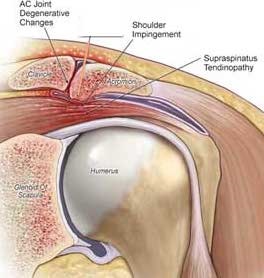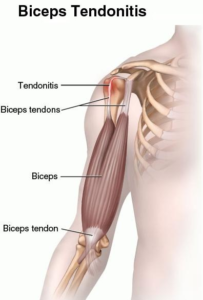The most common causes of shoulder pain are:
1. Tendon inflammation (Tendinosis), Bursitis or Rotator Cuff Tear:
 *Tendinosis
*Tendinosis
A tendon is a cord that connects muscle to its bony attachment and is in continuous use whenever the shoulder is in action. This Most tendinitis is a The continuous action of these tendons results in wear and tear changes within the substance of the tendon and, subsequently inflammation, which lead to thickening of the tendon. This leads to tendon entrapment and rubbing against bones, generating shoulder pain.
Tendenosis can affect any of the rotator cuff tendons, more frequently affecting the supraspinatus tendon.
Generally, Tendinosis is one of two types:
– Acute: can be ferry painful and debilitating if there is associated with calcium deposition. This is called calcific tendinosis.
– Chronic: Occurs due to repeated arm movement above the head. This is seen with jobs, such as decorators and electrician. Swimming or engaging in some types of athletic games is also a well-known cause of aching shoulder. Prolonged, wrong sitting position at work or at home is another precipitation factor.
– Patients who have arthritis or rheumatoid arthritis are susceptible to develop tendon inflammation and impingement.
* Calcific tendinosis:
Its where there is buildup of calcium with the tendon substance, causing hardening and swelling of the tendon and subsequently impingement against the acromion, and eventually pain. The shap of calcium is different than in acute calcific tendinosis.
*Bursitis:
Bursae are small, fluid-filled sacs that are located around tendons and joints throughout the body, including the shoulder. They act as cushions to reduce friction between bones and the overlying soft tissues.
Sometimes, excessive use of the shoulder leads to inflammation and swelling of the subacromial bursa around the shoulder, causing subacromial bursitis, impingement and subsequently pain.
The above can be diagnosed with ultrasound or MRI by a radiology consultant.
2.Frozen Shoulder :
The frozen shoulder condition was named as such because the patient develops a stiff shoulder with restricted movements in all directions. This usually develops after long duration of untreated shoulder pain for what ever the reason.
This above can be diagnosed with clinical examination in addition to ultrasound or MRI .
3.Chronic pain due to chronic advanced shoulder/gleno-humeral joint degeneration :
Shoulder joint (gleno-humeral joint) degeneration as another common cause of shoulder pain. This can be age related or secondary to trauma or chronic joint disease such as Rheumatoid arthritis.
The above can be diagnosed with Plain xray, CT or MRI.
4.Acromioclavicular joint arthritis and inflammation :
 Due to the frequent daily movements of the shoulder joint and tendons, irritation and injuries may occur within the acromioclavicular joint (known as collarbone joint), causing sever localized pain, tenderness on touching and may also cause localized swelling, especially on moving the shoulder in certain positions.
Due to the frequent daily movements of the shoulder joint and tendons, irritation and injuries may occur within the acromioclavicular joint (known as collarbone joint), causing sever localized pain, tenderness on touching and may also cause localized swelling, especially on moving the shoulder in certain positions.
The pain occurs at rest and usually worsens when performing sports or carrying heavy weights.
The above can be diagnosed with Plain xray, CT or MRI.
5.Biceps tendinopathy :
 This is a type of inflammation of the long head of the biceps tendon, occurs due to irritation caused by repeated carrying of heavy weight and physical activities.
This is a type of inflammation of the long head of the biceps tendon, occurs due to irritation caused by repeated carrying of heavy weight and physical activities.
If this condition persists, chronic inflammation may lead to complete tendon laceration/tear.
This can be diagnosed by ultrasound or MRI by a consultant radiologist.
6.Cervical nerve roots pressure effect :
Shoulder pain can be referred from the cervical spine as a result of the inflammation and narrowing of cervical neural spaces, compressing nerve roots supplying the arm.
This can be diagnosed by clinical examination and MRI .
7.Trauma/fracture :
This can cause severe and long-term pain, but is usually associated with trauma. This is mainly diagnosed with xray.
Other reasons for neck and shoulder pain include rheumatoid arthritis affecting the neck and shoulder.
Kindly call us 01277549029 for diagnosis and consultation.
You can contact us for any questions regarding Ultrasound injection treatment for Shoulder Pain relief.
